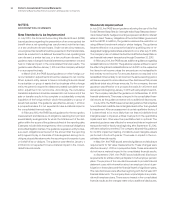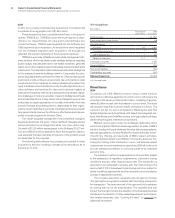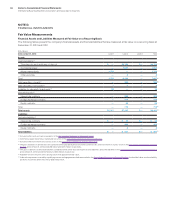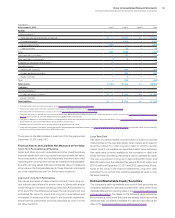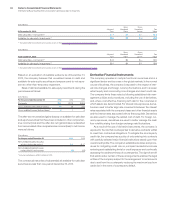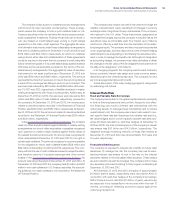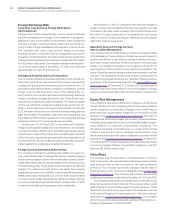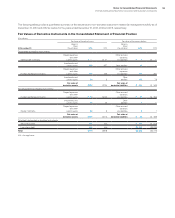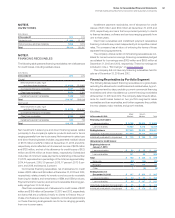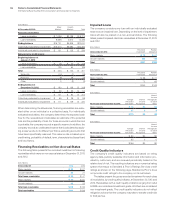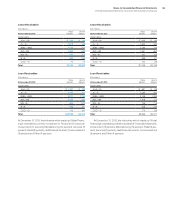IBM 2013 Annual Report Download - page 103
Download and view the complete annual report
Please find page 103 of the 2013 IBM annual report below. You can navigate through the pages in the report by either clicking on the pages listed below, or by using the keyword search tool below to find specific information within the annual report.
Notes to Consolidated Financial Statements
International Business Machines Corporation and Subsidiary Companies
102
($ in millions)
At December 31, 2013:
Adjusted
Cost
Gross
Unrealized
Gains
Gross
Unrealized
Losses
Fair
Value
Debt securities—noncurrent (1) $ 7 $1 $— $ 9
Available-for-sale equity investments (1) $20 $2 $ 4 $18
(1) Included within investments and sundry assets in the Consolidated Statement of Financial Position.
($ in millions)
At December 31, 2012:
Adjusted
Cost
Gross
Unrealized
Gains
Gross
Unrealized
Losses
Fair
Value
Debt securities—noncurrent (1) $ 8 $2 $— $10
Available-for-sale equity investments (1) $31 $4 $ 1 $34
(1) Included within investments and sundry assets in the Consolidated Statement of Financial Position.
Based on an evaluation of available evidence as of December 31,
2013, the company believes that unrealized losses on debt and
available-for-sale equity securities are temporary and do not repre-
sent an other-than-temporary impairment.
Sales of debt and available-for-sale equity investments during the
period were as follows:
($ in millions)
For the year ended December 31: 2013 2012 2011
Proceeds $41 $112 $405
Gross realized gains (before taxes) 13 45 232
Gross realized losses (before taxes) 51 0
The after-tax net unrealized gains/(losses) on available-for-sale debt
and equity securities that have been included in other comprehen-
sive income/(loss) and the after-tax net (gains)/losses reclassified
from accumulated other comprehensive income/(loss) to net income
were as follows:
($ in millions)
For the year ended December 31: 2013 2012
Net unrealized gains/(losses)
arising during the period $ 0 $ 17
Net unrealized (gains)/losses
reclassified to net income* (5) (25)
* Includes writedowns of $2.0 million in 2012.
The contractual maturities of substantially all available-for-sale debt
securities are less than one year at December 31, 2013.
Derivative Financial Instruments
The company operates in multiple functional currencies and is a
significant lender and borrower in the global markets. In the normal
course of business, the company is exposed to the impact of inter-
est rate changes and foreign currency fluctuations, and to a lesser
extent equity and commodity price changes and client credit risk.
The company limits these risks by following established risk man-
agement policies and procedures, including the use of derivatives,
and, where cost effective, financing with debt in the currencies in
which assets are denominated. For interest rate exposures, deriva-
tives are used to better align rate movements between the interest
rates associated with the company’s lease and other financial assets
and the interest rates associated with its financing debt. Derivatives
are also used to manage the related cost of debt. For foreign cur-
rency exposures, derivatives are used to better manage the cash
flow volatility arising from foreign exchange rate fluctuations.
As a result of the use of derivative instruments, the company is
exposed to the risk that counterparties to derivative contracts will fail
to meet their contractual obligations. To mitigate the counterparty
credit risk, the company has a policy of only entering into contracts
with carefully selected major financial institutions based upon their
overall credit profile. The company’s established policies and proce-
dures for mitigating credit risk on principal transactions include
reviewing and establishing limits for credit exposure and continually
assessing the creditworthiness of counterparties. The right of set-off
that exists under certain of these arrangements enables the legal
entities of the company subject to the arrangement to net amounts
due to and from the counterparty reducing the maximum loss from
credit risk in the event of counterparty default.




